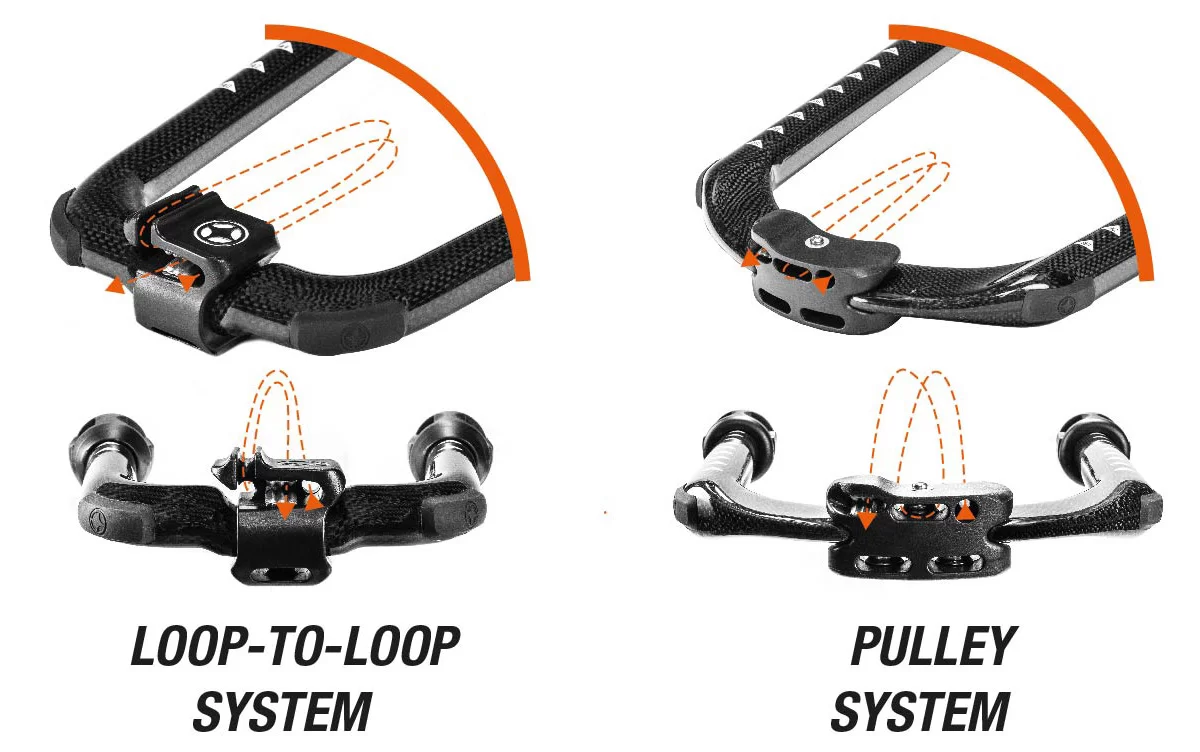Unsere Priorität bei Point-7 ist es, uns auf das Windsurf-Rigg zu konzentrieren und es zu einem Sieger-Rigg zu machen, unabhängig von der Disziplin. Der Windsurf Gabelbaum ist das, was wir beim Segeln mit unseren Händen fühlen. Dadurch spüren wir den Wind im Segel. Wir entwickeln Segel - wir haben das Racesegel entwickelt, das den PWA Slalom Weltmeister Titel gewonnen hat. Und ein Gabelbaum ist ein integraler Bestandteil dieses Riggs, der dem Fahrer eine gewinnbringende Leistung zur Verfügung stellt. Ein Aluminiumboom muss nicht nur einen guten Preis haben, ein Carbonboom muss sich nicht nur leicht und steif anfühlen. Hinter einem Gabelbaum und seinen Merkmalen steckt viel mehr, vor allem Komfort, Leistung und Sicherheit. Einige Gabelbäume sehen vielleicht gleich aus. Einige können leichter oder steifer sein als andere, aber das wichtigste Merkmal ist der Reflex. Dadurch kann sich ein Segel leicht oder schwer, kraftvoll oder komfortabler anfühlen. Der Reflex muss je nach Segelgröße und -bedingungen variieren. Ein 220er Racingboom kann nicht die gleiche Struktur wie ein 140er Waveboom haben. Genau wie bei den Masten ist die Synergie zwischen Baum und Mast sehr wichtig. Genau wie beim Segel und dem Mast. Was manchmal beim Betrachten eines Produkts am Strand diskutiert wird, führt möglicherweise nicht zum gleichen Ergebnis, wenn es einmal auf dem Wasser im Einsatz ist und unter Druck gesetzt wird.
Entwicklung:
Das erste Ziel des Point-7 Black Teams bei der Entwicklung eines Booms ist die Kurve. Hier geht es nicht darum, eine Kurve der neuen Generation zu erschaffen, wie manch einer meinen könnte. Es geht um eine Kurve, die es Deinem Vorder- und Hinterarm ermöglicht, während des Segelns eine natürliche ergonomische Position einzunehmen und das Segel automatisch im richtigen Winkel zu positionieren, damit der Wind in das Segel optimal ein- und ausströmen kann. Diese Position variiert mit der Windstärke und der Windsurfdisziplin, daher muss jede Boomgröße entsprechend entwickelt werden.
Die Kurve: Die Anforderungen an die Kurve eines Wavebooms unterscheiden sich stark von der eines Slalombooms, genau wie sich ein Slalomboom für Starkwind maßgeblich von einem Gabelbaum für Slalom bei leichtem Wind unterscheidet – gefragt ist jeweilige Kontrolle und die entsprechende Power. Die Entwicklung der richtigen Gabelbaumkurve liefert Komfort und Leistung.
Backend-Breite: Wir haben die richtige Heckbreite für jede Gabelbaumgröße und ihre Verwendung entwickelt. Die Breite des hinteren Endes eines Booms ist sehr wichtig - je breiter, desto mehr Leistung; je schmaler, desto mehr Kontrolle. Wir haben jede Größe auf den Prüfstand gestellt mit dem Ergebnis, dass sie am besten zu den Segelgrößen passt, für die sie entwickelt wurde.
Durchmesser: Der Durchmesser ist ein weiterer wichtiger Faktor, da er den Unterarmen Komfort bietet und Energieverschwendung auf dem Wasser vorbeugt. Für unseren Alu-Gabelbaum mussten wir einen Durchmesser wählen, der die Rohre steif genug macht und sich nicht mit der Zeit verbiegt. Die Wave-Gabelbäume 140 und 160 haben einen Durchmesser von 27 mm, und die größeren Größen ab 180 cm weisen 29 mm Durchmesser auf.
Steifheit: Die Steifheit eines Alu-Booms muss in der Lage sein die Böen zu kontrollieren, wenn sie auf das Segel treffen, und nicht nur den Flex. Obwohl wir nicht die gleiche Steifigkeit wie bei einem Carbonboom erwarten können, können wir aber den Rohrdurchmesser ändern. Wenn Du eine Gabelbaumgröße wählst, die zur Segelgröße passt, genießt Du die Leistung eines Alu-Booms.
Gewicht: Du kannst den leichtesten und steifsten Boom auf dem Markt haben. Wenn die Hauptmerkmale jedoch falsch sind, fühlt sich der Gabelbaum schwer und unkonfortabel an. Das Gewicht muss frontorientiert am Boom ausgerichtet sein, so dass das hintere Ende des Booms leicht bleibt. Ein schweres Heck lässt einen leichten Boom im Allgemeinen schwerer wirken als er wirklich ist. Daher ist ein leichtes Boomende das Wichtigste.
Konstruktion: Monocoque gebaut, einschließlich des Endstücks mit gebohrten Löchern.
Ausstattung:
- Boom Doppelpinclips für eine steifere Verbindung zwischen Gabelbaumkörper und Heck mit 2 cm Einstellungen. Verschiedene Pingrößen, die am besten zur jeweiligen Boomgröße passen.
- Gabelbaumkopf: Einfache automatische Montage am Mast. Der bewegliche Kopf neigt sich entsprechend der Montagehöhe am Mast, bewegt sich jedoch nicht von einer Seite zur anderen. Selbst bei geringer Seilspannung rutscht der Kopf nicht den Mast hinunter. Passt perfekt zu RDM-Adaptern.
- Boom Grip ist ein leicht geschliffener, rutschfester Pro Grip: Für einen festen Griff am Boom benötigst Du weniger Kraft. Einfache Positionierungsmarkierungen für die Trapeztampen.
- Flaschenzug System am Heckende: Die Wavegrößen haben ein Quick Loop System, während die Slalomgrößen Umlenkrollen (Pulleys) besitzen, um ein einstellbare Trimmsystem (adjustable outhaul system) aufzunehmen, oder sie ermöglichen andernfalls ein einfaches Belegen des Tampens, um die Clew-Spannung zu fixieren.
| ALU+ | TYPE | SAIL RAGE | MAX LENGHT (cm) | EXT (cm) | SIZE INTERVALS (cm) | BOOM HEAD | DIAM(MM) | DIAM. SHAPE | WEIGHT (KG) (+-5%) | WIDEST POINT(cm) | TAIL WIDTH (INTERNAL) (cm) | TAIL TYPE |
|---|---|---|---|---|---|---|---|---|---|---|---|---|
| 140 | Wave Freestyle | 3.3-6.4 | 190 | 50 | 2 | RDM | 26 | Round | 2.3 | 38 | 12 | Int. |
| 160 | Wave Freestyle Freeride | 4.7-7.2 | 210 | 50 | 2 | SDM | 26 | Round | 2.7 | 41,5 | 12 | Int. |
| 180 | Freeride Slalom | 5.4-8.5 | 230 | 50 | 2 | SDM | 28 | Round | 2.8 | 48 | 14,5 | Int. |
| 200 | Freeride Slalom | 6.8-9.4 | 250 | 50 | 2 | SDM | 28 | Round | 2.9 | 51 | 14,5 | Int. |
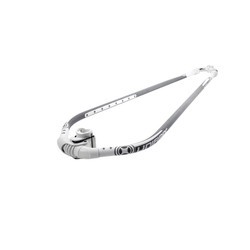
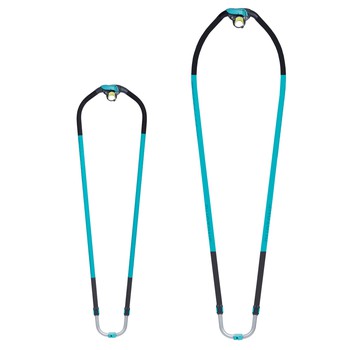

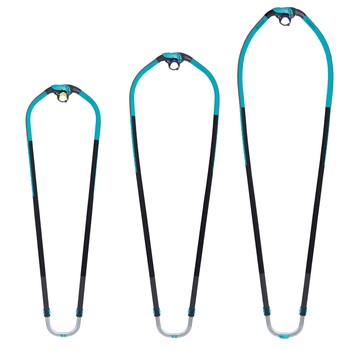
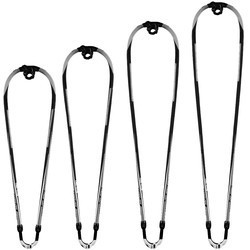
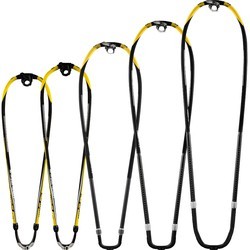
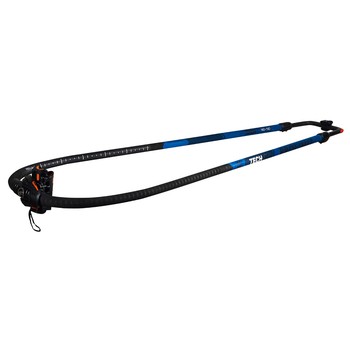
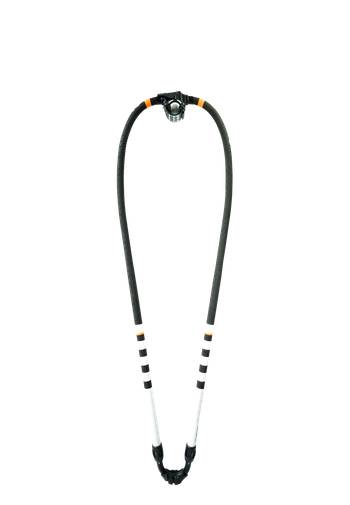
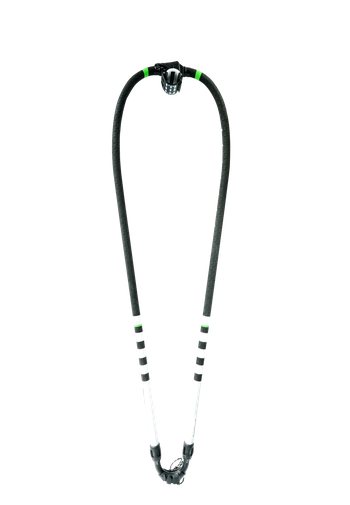
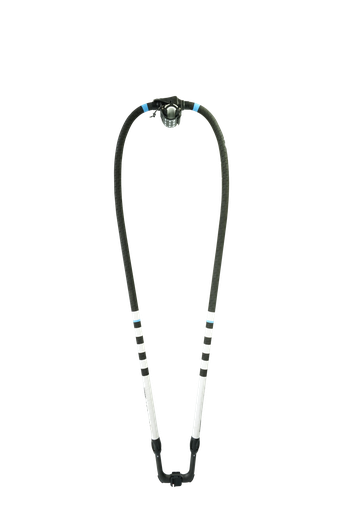
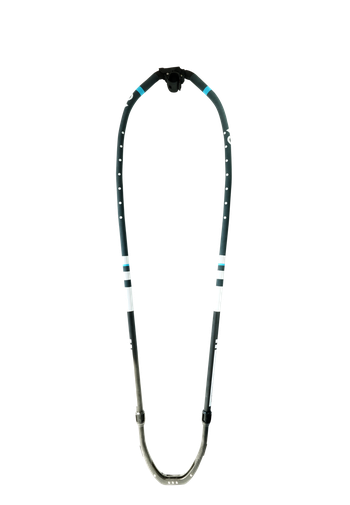
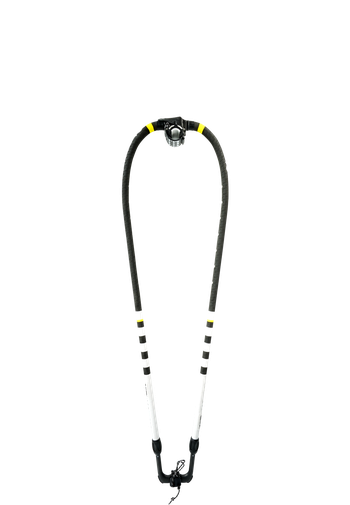
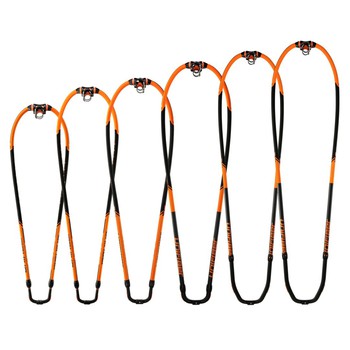

Der Windsurf Gabelbaum (Boom)
Der Gabelbaum (auch Boom gennant) ist das Verbindungsstück zwischen dem Segel und dem Surfer. Zusammen mit dem Segel und dem Mast bildet es das Rigg beim Windsurfen. Unterscheiden kann man den Gabelbaum in , die Länge, das Material und den Durchmesser der Gabelbaumrohre, den Holmen.
Es haben sich über die Jahre 3 Formen herausgebildet:
Je nach Bauch des Segels wird mehr Platz in der Gabelbaumform (=breitere Gabel) benötigt. Das Wave-Segel mit sehr wenig Bauch benötigt die schmalste Gabelbaumform , gefolgt von Freeride- und und den Race-Gabelbäumen. Je schmaler die Form des Gabelbaums, umso direkter der Kontakt zum Segelmittelpunkt . Dadurch erhält man ein direkteres Fahrgefühl. Als Empfehlung kann man Segel zu folgenden Gabelbäumen raten:
1) Kleine Freemove und Freestyle Segel surfen sich neben Wavesegeln bestens mit Wave-Gabeln
2) Größere Freemovesegel (ab etwa 5,0qm), Racesegel (unter ca. 6qm) und Freeride Segel eignen sich besser mit Freeride-Gabeln
3) Große Freeride, Freerace und Racessegel (ab ca. 6,5qm) sind optimal mit Race-Gabeln zu surfen
Auf jedem Segel findet sich auch eine Angabe zur bestmöglichen Länge des Gabelbaumes („BOOM“). Diese Angabe ist der Richtwert. Bei unterschiedlichen Windverhältnissen empfiehlt es sich aber das Schothorn stark durchzuziehen, die Länge des Gabelbaums länger einzustellen. Dies führt dazu, dass der obere Teil des Achterlieks bei Böen aufmacht und die Segelfläche für eine kurze Zeit verkleinert. Bei schwächerem Wind empfiehlt es sich das Schothorn eher weniger zu spannen um so einen größeren Segelbauch zu erreichen. Hiermit erhöht sich die Segelfläche und man gleitet früher an. Der Verstellbereich der meisten Gabelbäumen beläuft sich auf ca. 40 cm bis 60 cm Einstellbereich. Dadurch kann man den Gabelbaum für mehrere Segelgrößen verwenden. Allerdings sollte der Gabelbaum möglichst nicht in voll ausgefahren werden , da dadurch die Steifheit der Gabel nachlässt.
Die Steifheit eines Gabelbaumes ist abhängig vom Material. Die Verschiedenen Modelle sind reine Gabelbäume aus Aluminium,, reine Carbon Gabelbäume und Hybrid Gabelbäume, bei denen Holme aus Aluminium und das Endstück aus Carbon hergestellt werden.
Aluminium Gabelbäume sind am günstigsten. Man muss jedoch auch gewisse Abstriche in der Steifheit des Gabelbaumes machen. Die stabilsten und auch leichtesten Gabelbäume sind die Carbongabelbäume.i
Der Durchmesser der Holmen
Der Durchmesser der Holmen (Rohre) beschreibt jeweils den Durchmesser ohne Belag. Meist mittlerweile bei etwa 29mm. Es gibt sie aber auch mit reduziertem Durchmesser, , meist für Freestyle und Wavesegel mit ca. 26mm Durchmesser. Diese haben allerdings durch den geringeren Durchmesser meist eine geringere Steifheit. Deshalb wird hier meist ein Carbongabelbaum genommen , damit die Steifheit wieder gegeben ist. Racegabeln haben meist einen Durchmesser von 32mm, da im Race-Bereich durch die großen Segelflächen stärkere Kräfte auf den Gabelbaum wirken.
Passt dein Gabelbaum zu deinem Mast? Es gibt Gabelbäume mit integriertem RDM Adapter. Diese sind optimal auf die Verwendung von „Skinny“-RDM ( reduced - verkleinert) Masten ausgelegt. Für andere Gabelbäume lassen sich handelsübliche „Skinny“-Adapter erwerben. Diese steckt man einfach auf den RDM Mast, um diesen an der Verbindungsstelle zum Gabelbaum auf SDM (Standard) Durchmesser anzupassen.
Rugged aluminium and carbon windsurfing booms for comfortable, efficient sailing across all windsurf disciplinesWith kids' styles, traditional ‘R’ (regular) and modern ‘C' outline shapes - and options on tube section, grip diameter, and tail width - Unifiber have booms to suit all budgets and preferences.There are many points to consider when purchasing a new boom, whether it’s a replacement or your very first one!Let's discuss the key factors to consider when choosing a boom...
The choice between aluminium and carbon is mostly budget related. Aluminium booms generally retail between 100€ and 300€, drastically less than carbon booms.Aluminium booms are available in different constructions and configurations, all using the same grade T8 aluminium alloy. A stronger, monocoque shaped boom body provides stiffness and durability. The Heavy Duty (HD) monocoque body has increased tube wall thickness to get even closer to the stability found in carbon booms. Additionally, our booms are available as arms-only to be retrofitted to other boom heads.Carbon booms range between 500€ and 1000€. They are much stiffer than aluminium booms, so when you are sailing they deliver instant responsiveness to your rig, and help to maintain better sail profile leading to performance gains. Unifiber produces a Limited Edition (LE) carbon boom, that uses a special composite lay-up technique that optimizes cost of production, resulting in a great price to quality ratio. The rest of the Unifiber line of carbon booms represents absolute top of the line, with similar shape and parts as LE booms but using the highest spec carbon tubes to ensure best possible performance.Boom stiffness is one of the most important performance indicators. The stiffer the boom, the less deformation of the sail profile. Especially in overpowered conditions stiffer booms provide better top end control and responsiveness.
The diameter of the boom tubes impacts upon comfort and stiffness. Larger diameter booms are typically more stiff, resulting in improved performance. Many people with 'average' sized hands find the most comfortable boom tube diameter to be around 27/28mm, but this is a matter for personal preference.
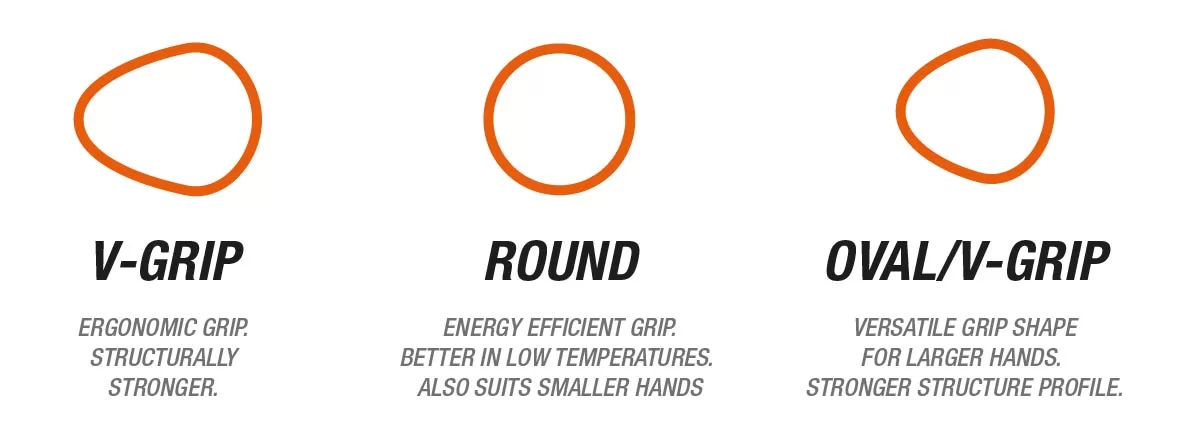
When using bigger sail sizes, typically around 6.8 and larger, it is sensible to consider a boom with a wider tail. Wide tail booms ensure the sail profile will not be disturbed when sailing with low outhaul tension, as is often the case in lighter wind conditions. In contrast, narrow tail booms - particularly if used with bigger sails - can touch and deform the sail profile, resulting in sub-optimal performance and potentially compromising sail durability.
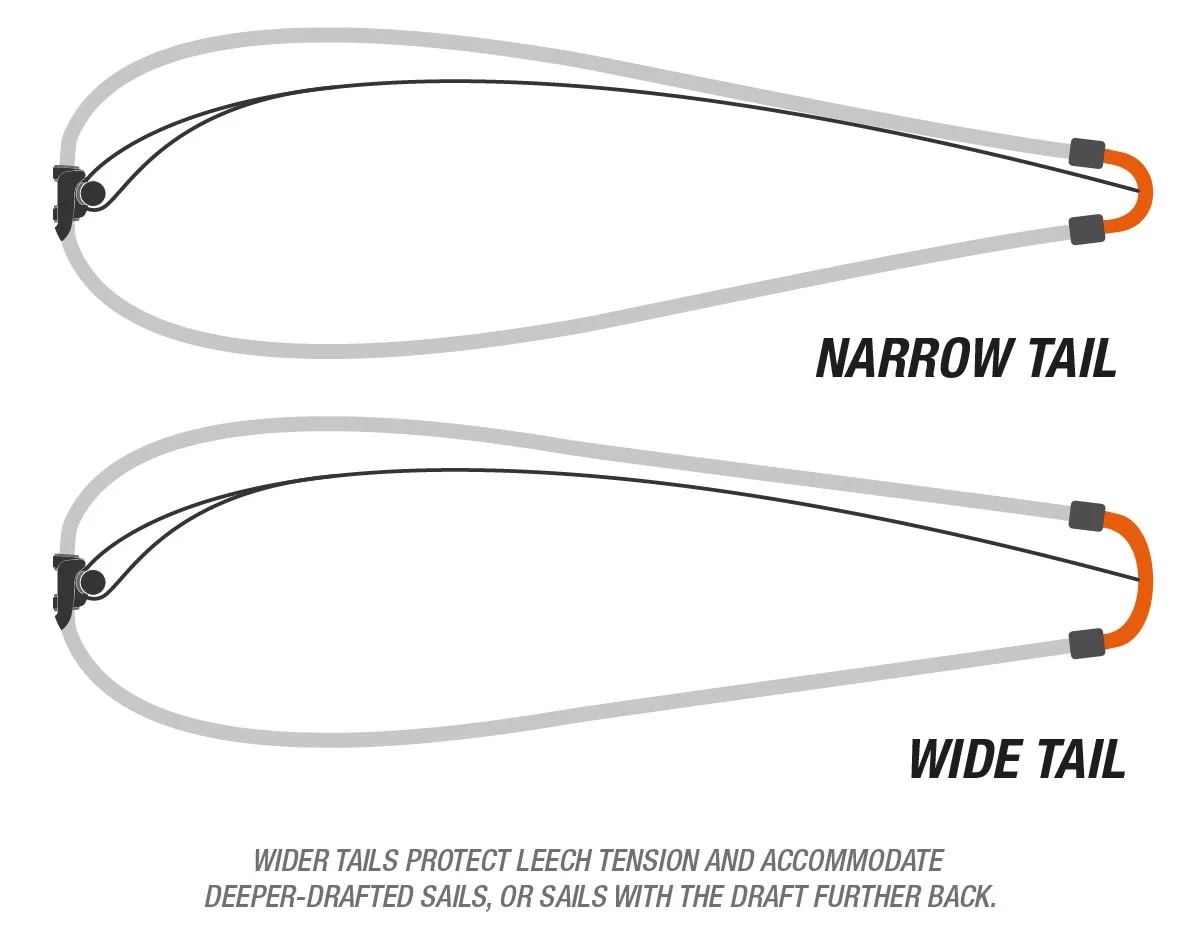
Traditional 'R' shaped boom accommodate deeper sail profiles, so are particularly relevant when considering larger sail sizes. A disadvantage is that they require the mast (front) hand to have the wrist slightly bent. ‘C’ shape booms have ergonomic advantages since they allow the lead arm to take a more natural wrist position. This applies to straight line blasting, but can also make for more comfortable gybing and other manoeuvres too.
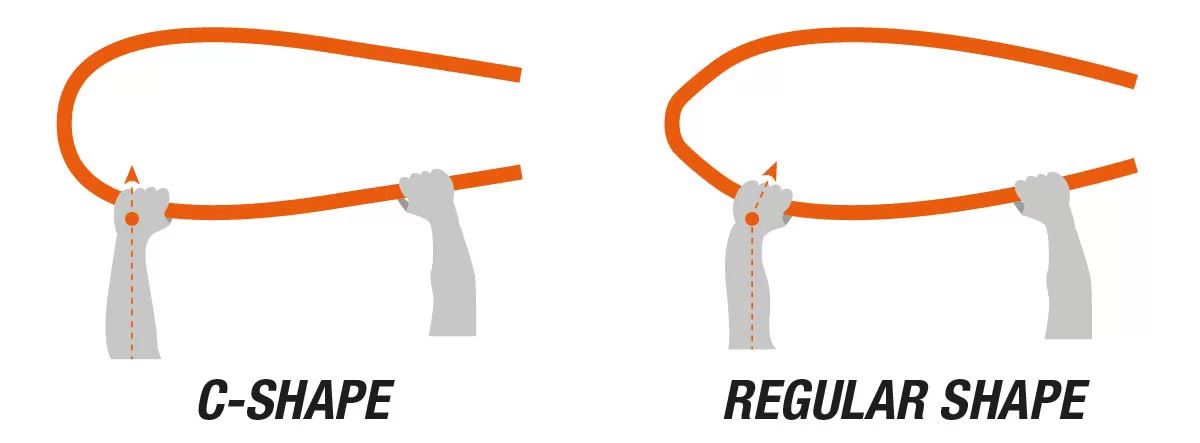
When you are sailing in powered up conditions, the forces acting on your boom attempt to make it wider, and consequently shorter. A shorter boom allows the sail to balloon - which is exactly what you don't want when a big gust hits. That's why you want a stiff boom.
Increasing the boom body wall thickness increases the stiffness of the boom. Thicker wall thicknesses also make for a stronger and more durable boom. The downside of increased wall thickness is of course added weight. We rate all our booms for stiffness with a star system. One * star is least stiff; a seven star ******* rating represents maximum amount of stiffness Unifiber
Most booms are equipped with an axial moving boom head. A moving head is necessary because the angle between mast and boom is variable - depending upon the sail design, sailor's preferred boom height, and other factors.
Accommodating for this variation in boom angle - by allowing axial movement - is very important because it prevents point loading between the mast and boom head.
By evenly distributing the forces between mast and boom, the durability and reliability of both will be much increased.
A well designed axially mobile boom head will also facilitate sail rigging and boom height adjustments.
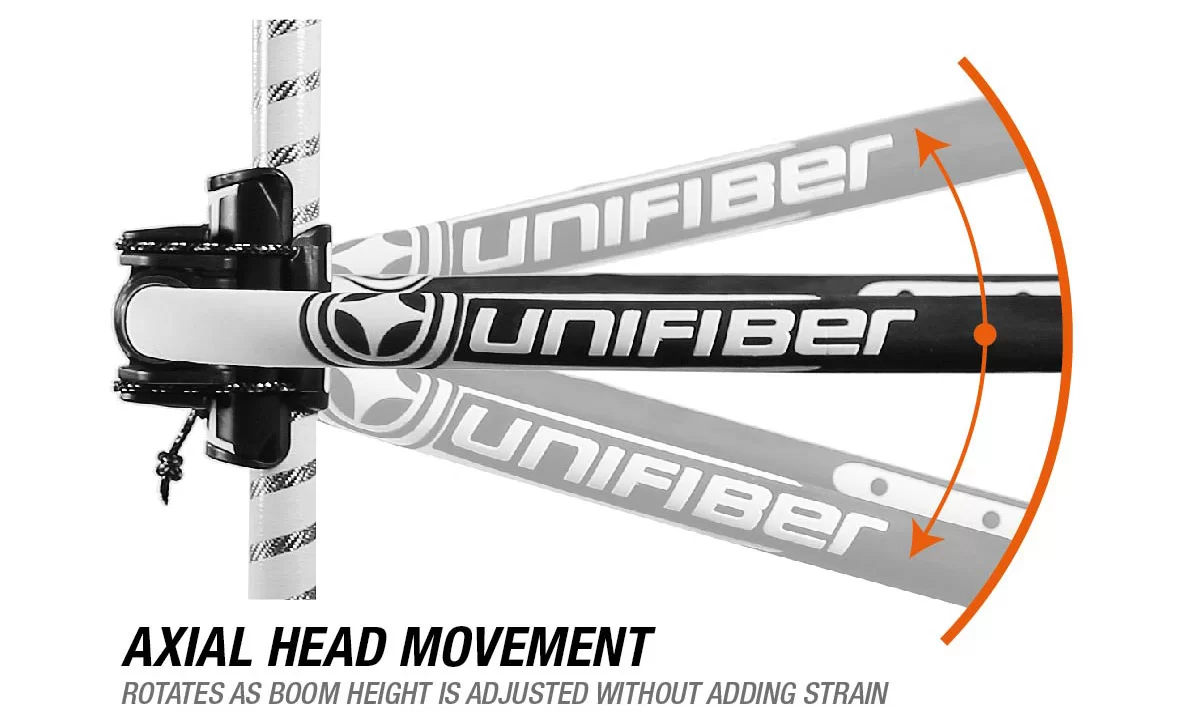
When buying a new boom check for mast diameter compatibility. Most booms will work with a Standard Diameter Mast (SDM), but might need an adapter to work with a Reduced Diameter Mast (RDM).
Some boom heads can adapt to both RDM and SDM masts, without requiring a separate adapter.
Other boom clamps don't naturally adapt to RDM mast sizes, but have removable adaptors to make this possible.
For booms that don't fit RDM and that don't include RDM adaptors, a collar type adaptor can be fitted to the mast instead, which brings the diameter up to SDM size.
Most windsurf sails quote an outhaul setting range that corresponds to the boom length setting required.
But do consider that there is slight variation in how the different sail manufacturers arrive at their recommended measurements, and the actual setting required will depends on conditions, boom height and other factors.
When using a boom at the minimum or close to the minimum setting it will add a lot of stiffness, increasing the performance of your rig.
When a boom is used near the limit of its extension range it will be less stiff. For this reason most Unifiber aluminium booms extend a maximum of 50cm, while the - inherently stiffer - Unifiber carbon booms can be extended up to 60cm.
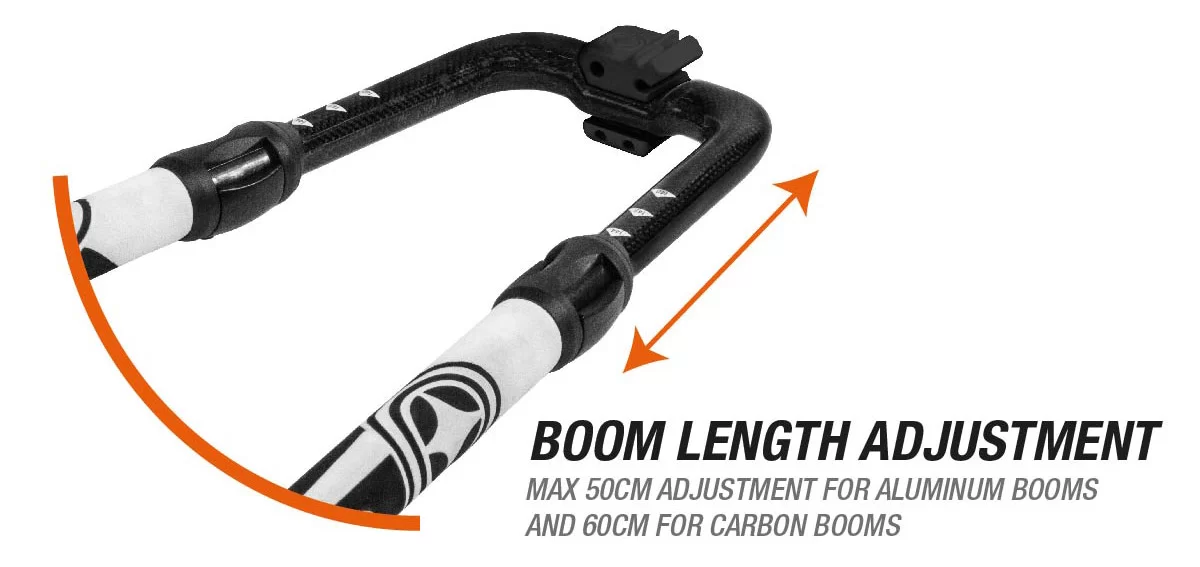
There are two main options for the boom tail: a wider diameter tail that goes outside the boom body, or a narrower diameter tail that goes inside.
The tail inside option allows for the length adjustment lock to be fixed at the end of the boom body - which allows for simple operation. A disadvantage is that the tail itself - being of narrower diameter - is less stiff.
The tail outside option requires a wider diameter boom tail, which adds to stiffness. A disadvantage of this system is that locating the holes for the length adjustment lock can sometimes be difficult.
For shorter sized booms the tail outside option is not offered, as the tail would interfere with the back hand during normal sailing.
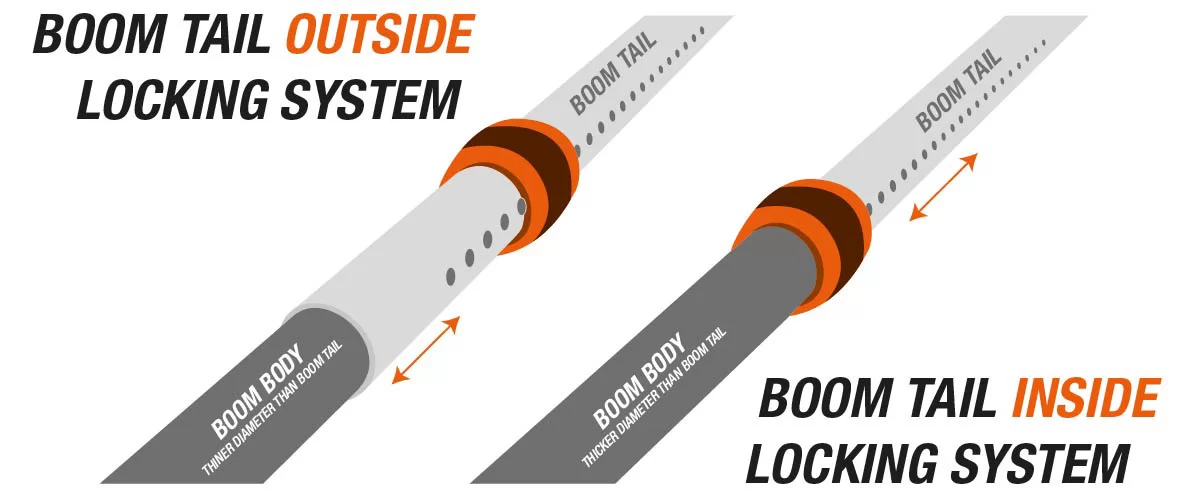
For quick rigging, the loop-loop-go (loop-to-loop) option is most convenient. This is the best option for medium-sized and smaller sails, and will help get you rigged and out on the water quickly!
The pulley-option provides a solution for use on booms fitted with an adjustable outhaul system. This is a great feature for bigger sails and racing.
